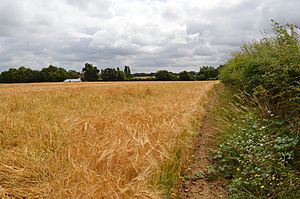Newney Green Pit facts for kids
| Site of Special Scientific Interest | |
 |
|
| Area of Search | Essex |
|---|---|
| Interest | Geological |
| Area | 0.07 hectares |
| Notification | 1989 |
| Location map | Magic Map |
Newney Green Pit is a tiny but very important geological site in Essex, England. It is located west of a town called Writtle. This special area is only about 0.07 hectares, which is smaller than a football field!
It's known as a Site of Special Scientific Interest (SSSI) because of its unique geological features. It's also recognized as a Geological Conservation Review (GCR) site. This means it helps scientists learn about Earth's ancient past.
Contents
What Makes Newney Green Pit Special?
Newney Green Pit used to be a quarry, which is a place where rocks or gravel are dug out of the ground. When people dug here, they uncovered layers of Earth that tell an amazing story. These layers show us what the area was like hundreds of thousands of years ago.
A Window into Earth's Ancient History
The layers of gravel and soil at Newney Green Pit are like pages in a history book. They help scientists understand how the landscape changed over time. This site is especially important for connecting geological findings from the River Thames area with those in East Anglia.
The Kesgrave Gravel Story
One of the most important things found here is something called the Kesgrave Gravel. This gravel was first discovered in Suffolk, another county in England. It was laid down by an ancient version of the River Thames.
Scientists believe this gravel dates back about 500,000 years ago. This time period is known as the Cromerian interglacial. An "interglacial" period is a warmer time between two ice ages.
Clues from the Ice Age
The layers at Newney Green Pit also show evidence of the very cold Anglian Ice Age. This was a much colder period that happened after the Cromerian interglacial. The Anglian Ice Age was so severe that huge ice sheets covered much of Britain.
Just below the Anglian layer, scientists found something called "ice wedge polygons." These are special shapes in the ground that form when the soil freezes and thaws over and over again. They show that the weather was extremely cold just before the massive ice sheet moved across East Anglia.
What Does Newney Green Pit Look Like Today?
Even though it was once a quarry, Newney Green Pit has changed. The site has now been filled in. Today, it looks like a normal part of a field. However, its history and the scientific discoveries made there are still very important.

